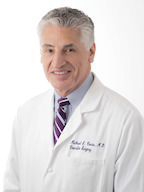Aortofemoral Bypass Surgery
Aortofemoral bypass surgery (also called aorto-BI-femoral bypass surgery) is used to bypass diseased large blood vessels in the abdomen and groin. If the blockage is in the arteries in the pelvis, the bypass needs to run from the aorta in the abdomen to the femoral arteries in the groin.
Atherosclerosis is the buildup of fatty deposits within the wall of the arteries within the body. When this occurs in the arteries to the legs, it is called peripheral arterial disease. The narrowing or even blockage of the arteries to the legs can cause a variety of problems depending on how severe it is. Some patients have no symptoms at all, while others suffer pain on exercise (intermittent claudication). If the circulation to the legs gets even worse, then persistent pain may be felt in the foot and gangrene may occur. The blockage usually must be causing significant symptoms or be limb-threatening before bypass surgery is considered.
To bypass the blocked blood vessel, blood is redirected through a graft made of synthetic material. This graft is sewn above and below the diseased artery so that blood flows through the graft. The artificial blood vessel is formed into a Y shape. The single end of the Y is sewn on the aorta. The two split ends of the Y are sewn below the blocked or narrowed areas of the femoral arteries. This allows the blood to travel around (bypass) the diseased areas.
General anesthesia is used and will cause the patient to sleep through the procedure. The procedure itself generally takes three to five hours, but the preparation and recovery time add several hours.
After Surgery
You will likely stay in the hospital 4 to 7 days, and you can expect your belly and groin to be sore for several weeks. You will probably feel more tired than usual for several weeks.
You may be able to do many of your usual activities after 4 to 6 weeks, but you will likely need 2 to 3 months to fully recover, especially if you typically do a lot of physical activities.
You will probably need to take at least 4 to 6 weeks off from work--this depends on the type of work you do and how you feel.
Risks
All surgeries carry a certain amount of risk. These risks include:
- Infection from the incision
- Bleeding
- Heart attack or stroke
Specific risks for aortofemoral bypass surgery include:
- Leg swelling
- Failed or blocked grafts
- Sexual dysfunction caused by nerve damage in the pelvis
The actual risk varies from patient to patient and largely depends on the presence of other medical problems, such as heart, lung and kidney diseases. Tests performed before the operation help to identify patients that have these medical problems and are therefore at higher risk. In some cases, medication can be started to help reduce the risk of complications, such as aspirin and statin tablets for heart disease, or inhaler treatments for lung disease. Unfortunately, for some patients, little can be done to lower surgical risk, but knowing this helps the patient and surgeon come to a decision about whether surgery should be attempted.











